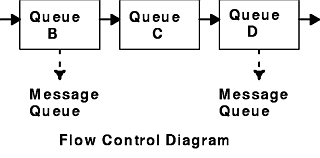[ Previous | Next | Table of Contents | Index | Library Home |
Legal |
Search ]
Communications Programming Concepts
Even on a well-designed system,
general system delays, malfunctions, and excessive accumulation on one or more
streams can cause the message buffer pools to become depleted.
Additionally, processing bursts can arise when a service procedure in one
module has a long message queue and processes all its messages in one
pass. STREAMS provides an independent mechanism to guard its message
buffer pools from being depleted and to minimize long processing bursts at any
one module.
Note: Flow
control is applied only to normal priority messages.
The flow control mechanism is
local to each stream and is advisory (voluntary), and it limits the number of
characters that can be queued for processing at any QUEUE in a stream.
This mechanism limits the buffers and related processing at any one QUEUE and
in any one stream, but does not consider buffer pool levels or buffer usage in
other streams.
The advisory mechanism operates
between the two nearest QUEUEs in a stream containing service
procedures. Messages are generally held on a message queue only if a
service procedure is present in the associated QUEUE.
Messages accumulate at a QUEUE
when its service procedure processing does not keep pace with the message
arrival rate, or when the procedure is blocked from placing its messages on
the following stream component by the flow-control mechanism. Pushable
modules contain independent upstream and downstream limits, which are set when
a developer specifies high-water and low-water control values for the
QUEUE. The stream head contains a preset upstream limit (which can be
modified by a special message sent from downstream) and a driver may contain a
downstream limit.
STREAMS flow control operates in
the following order:
- Each time a STREAMS
message-handling routine (for example, the putq utility) adds or removes a message from a
message queue in a QUEUE, the limits are checked. STREAMS calculates
the total size of all message blocks on the message queue.
- The total is compared to the
QUEUE high-water and low-water values. If the total exceeds the
high-water value, an internal full indicator is set for the QUEUE. The
operation of the service procedure in this QUEUE is not affected if the
indicator is set, and the service procedure
continues to be scheduled.
- The next part of flow control
processing occurs in the nearest preceding QUEUE that contains a service
procedure. In the Flow Control diagram, if
D is full and C has no service procedure, then B is the nearest preceding
QUEUE.
Figure 10-3. Flow Control. This diagram shows queue B, queue C, and queue D side-by-side. Beside each queue is an arrow coming from the left pointing toward that queue, then another arrow leaving that queue and pointing to the queue on the right. There are dashed arrows leading down from queue B and queue D to message queues.

- In the Flow Control Diagram, the service procedure in B
uses a STREAMS utility routine to see if a QUEUE ahead is marked full.
If messages cannot be sent, the scheduler blocks the service procedure in B
from further execution. B remains blocked until the low-water mark of
the full QUEUE D is reached.
- While B is blocked (in the Flow Control Diagram), any
nonpriority messages that arrive at B will accumulate on its message queue (recall that priority messages are not
blocked). In turn, B can reach a full state and the full condition will
propagate back to the last module in the stream.
- When the service procedure processing on D (in the Flow
Control Diagram) causes the message block total to
fall below the low-water mark, the full indicator is turned off. Then
STREAMS automatically schedules the nearest preceding blocked QUEUE (in this
case, B) and gets things moving again. This automatic scheduling is
known as back-enabling a QUEUE.
To use flow control, a developer
need only call the utility that tests if a full condition exists ahead (for
example, the canput utility), and perform
some housekeeping if it does. Everything else is automatically handled
by STREAMS.
See "STREAMS
Messages" for more information about the STREAMS message-passing
scheme.
[ Previous | Next | Table of Contents | Index |
Library Home |
Legal |
Search ]
